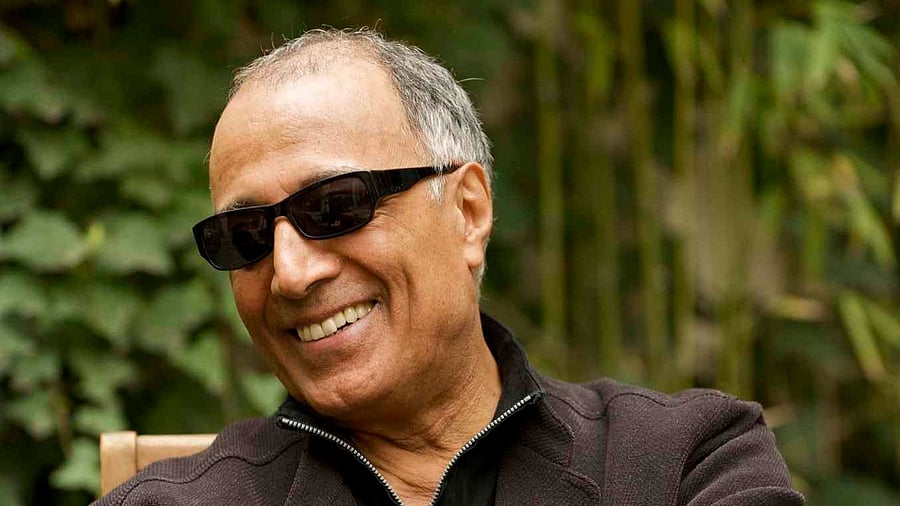
Abbas Kiarostami.
Credit: MK2 Films
Once Jean Luc-Godard, a filmmaker of French New Wave, said, “Cinema starts with D W Griffith and ends with Abbas Kiarostami”. Whether you agree with his words or not, with the transformation of cinema taking its shapes and forms according to the budget, market and viewership in the past two decades, very few people are concerned about its artistic values, creativity and experimentation. But, if you go through art history, people thought painting was dead when still cameras were invented. But, artistes took the challenge in the western world. They emphasised the inner expression of an artiste which led to different “isms” and movements, like impressionism, expressionism, cubism, surrealism, and Dadaism.
Cinema is no longer a collective art form. Most cinema theatres are shutting down across the world. People now watch films on their mobile phones. Watching films on the big screen has become very expensive. However, a great opportunity for cinephiles is the retrospective of Kiarostami at the Bengaluru International Film Festival this year. Reflecting on the impact of cinema, Ingmar Bergman had once said: “No art passes our conscience in the way film does, and goes directly to our feelings, deep down into the dark rooms of our souls.”
Christian Jeune, the director of Festival de Cannes, wrote a letter to me after watching the first cut of my feature film Attihannu Mattu Kanaja (Fig Fruit and The Wasps) at the NFDC Film Bazaar in 2013. His letter read: “I have seen ‘Fig Fruit and the Wasps’ and I found it very interesting, it belongs to the same family of films by Abbas Kiarostami (and that’s a compliment for me) with a very Indian touch of course. The notion of time is strong and your camera lingers on the essential.”
I admire his works for his poetic vision, simplicity, and mystic transcendental approach to filmmaking. His later works look simple, but are more complex in the treatment. Especially from The Wind Will Carry Us onwards, Ten, Five Dedicated to Ozu, Shirin, Certified Copy and Like Someone in Love. Certified Copy and Like Someone in Love are located in foreign countries, one in Italy, and the other one in Japan. Kiarostami is normally known for making films with amateur actors and almost no budget. But he had said he had no difficulties in making the transition to European cinema: “This was the simplest film for me to work on — even simpler than the work I’ve done on my shorts because I was working with a professional team both in front of and behind the camera.” He also noted how he for once felt free to express whatever he wanted in the film.
The Wind Will Carry Us' explores a journalist visiting a Kurdish village.
Credit: IMDb
Kiarostami started his career as a visual artiste, just like Satyajit Ray and Akira Kurosawa. He studied painting and graphic design at the University of Tehran, School of Fine Arts. As a painter, designer, and illustrator, Kiarostami worked in advertising in the 1960s, designing posters and creating commercials. He shot advertisements for Iranian television. In the late 1960s, he began creating credit titles for films and illustrating children’s books. He was also a poet and photographer and published poetry collections in Persian.
In 1970, when the Iranian New Wave began with Dariush Mehrjui’s film Cow, Kiarostami helped set up a filmmaking department at the Institute for Intellectual Development of Children and Young Adults in Tehran. Its debut production, and Kiarostami’s first film, was the twelve-minute The Bread and Alley (1970), a neo-realistic short film about a schoolboy’s confrontation with an aggressive dog. From there onwards, he directed several short and mid-length films including Two Solutions for One Problem, Colors, A Wedding Suit and Report (1977) with a 112-minute runtime. It was considerably longer than his previous work, Orderly or Disorderly (1981), and The Chorus (1982).
It was not until his film Where Is the Friend’s House? (1987) that he began to gain recognition outside Iran. From this film onwards he began to cultivate his aesthetics, idioms, politics and language of filmmaking. One can observe the simplicity he achieved in cinema compared to Yasujiro Ozu and Rober Bresson. Kiarostami’s films contain ambiguity, an unusual mixture of simplicity and complexity, and a blend of fictional and documentary elements.
'Where Is My Friend's House?' is about a child's innocence and concern for his fellow classmate.
Credit: IMDb
In the film Close-up, a denunciation of the cinematographic illusion leads to the contrary in the end, a return to the real that a progressive fading away of the movie signals. A bunch of red flowers stand out against the blue-grey of the noisy street. One can see a similar kind of cinematographic illusion in Michelangelo Antonioni’s Blow-up (1966).
(The author is a filmmaker and visual artiste)